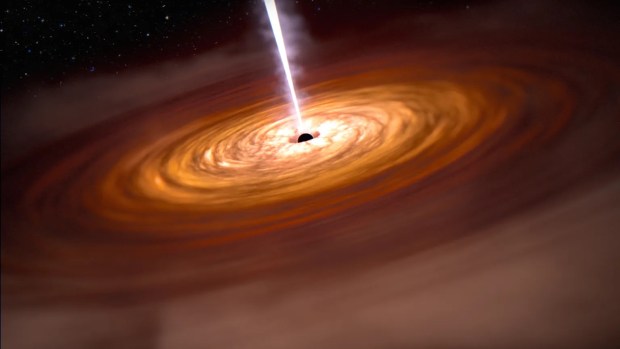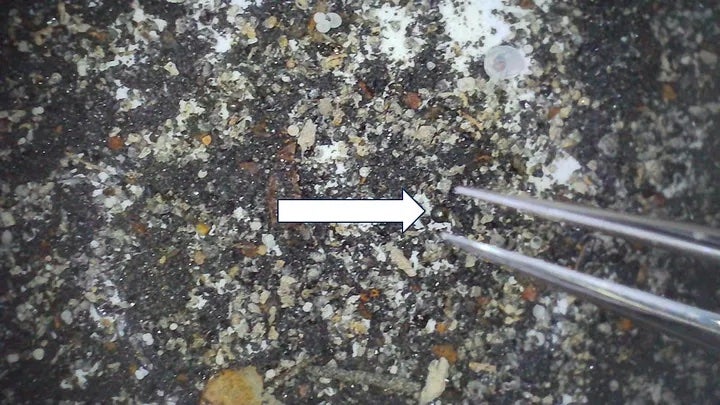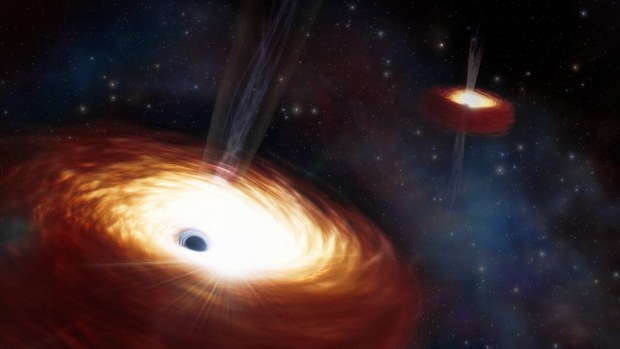In 2011, MPE astronomers detected a gas cloud that is falling toward the black hole at the center of our Milky Way on a near radial orbit. New sensitive data taken in April 2013 with the SINFONI instrument at the European Southern Observatory’s Very Large Telescope have now shown that part of the cloud has already passed its closest approach to the black hole. As the gas swings by the black hole, it reverses its velocity. The emission from this part of the cloud appears not redshifted as does the radiation from the rest of the cloud, but rather blueshifted.
“The ionized gas at the head of the cloud is now stretched over more than 150 light-hours (about 160 billion kilometers [99 billion miles]) at the pericenter of the orbit around the black hole, with the closest approach being about 25 light-hours (or a bit more than 25 billion km [16 billion miles]),” said Stefan Gillessen from MPE, who led the observing team. “The pericenter approach, however, is not a singular event but rather a process that will be stretching over a period of at least one year.”
Previous estimates of the gas cloud orbit had predicted the nominal pericenter passage for later in the year, while the new analysis prefers a date early in 2014 — a difference that is less than the duration of the event. In addition to the new observations, the team also reanalyzed archival data and can now give a better measurement of the cloud’s orbit. The fastest components appear to move with a red-shifted velocity of 1,900 miles (3,000km) per second), while the brightest part of the head moves with about 1,400 miles (2,180km) per second. Further down the orbit, there seems to follow a tail moving much slower with a velocity of only 400 miles (700km) per second but along the same orbit.
“But the most exciting detection is gas emission with a blueshifted velocity of 3,000 km/s along the orbit at a position after pericenter,” said Gillessen. “This means that part of the cloud has already passed the closest approach to the black hole. This could also affect our models of the gas cloud orbit as the brightest part of the head structure might not be comparable any longer to the head in 2012.” Measurements of the radial velocity seem to confirm this suspicion. The increase in velocity seems to be less than expected because the fastest particles have already moved to the other side of the black hole and thus no longer contribute to the velocity of the still redshifted part.
In addition, the new data shed light on the enigmatic origin of the gas cloud. Several options have been proposed, ranging from recent formation due to a collision between stellar winds and the interstellar medium or the possible jet emerging from the galactic center to a faint star that loses increasing amounts of gas. While the compactness of the gas cloud seems surprising for any of these scenarios, the shape of the tidal shear argues against models with a stellar core that would constantly supply new gas. Instead, the orientation of the orbit continues to favor an origin connected to the disk of young massive stars surrounding the black hole farther out.
Numerous observing campaigns have been set up to intensely monitor the region around the galactic center in 2013. This should provide the astronomers with a wealth of data, further constraining the parameters of the gas cloud but also giving interesting information about the surroundings of the black hole. The growing extension and the correspondingly decreasing surface brightness of the gas, however, will make such a detection difficult. The gas cloud is fading as it passes around the black hole.










